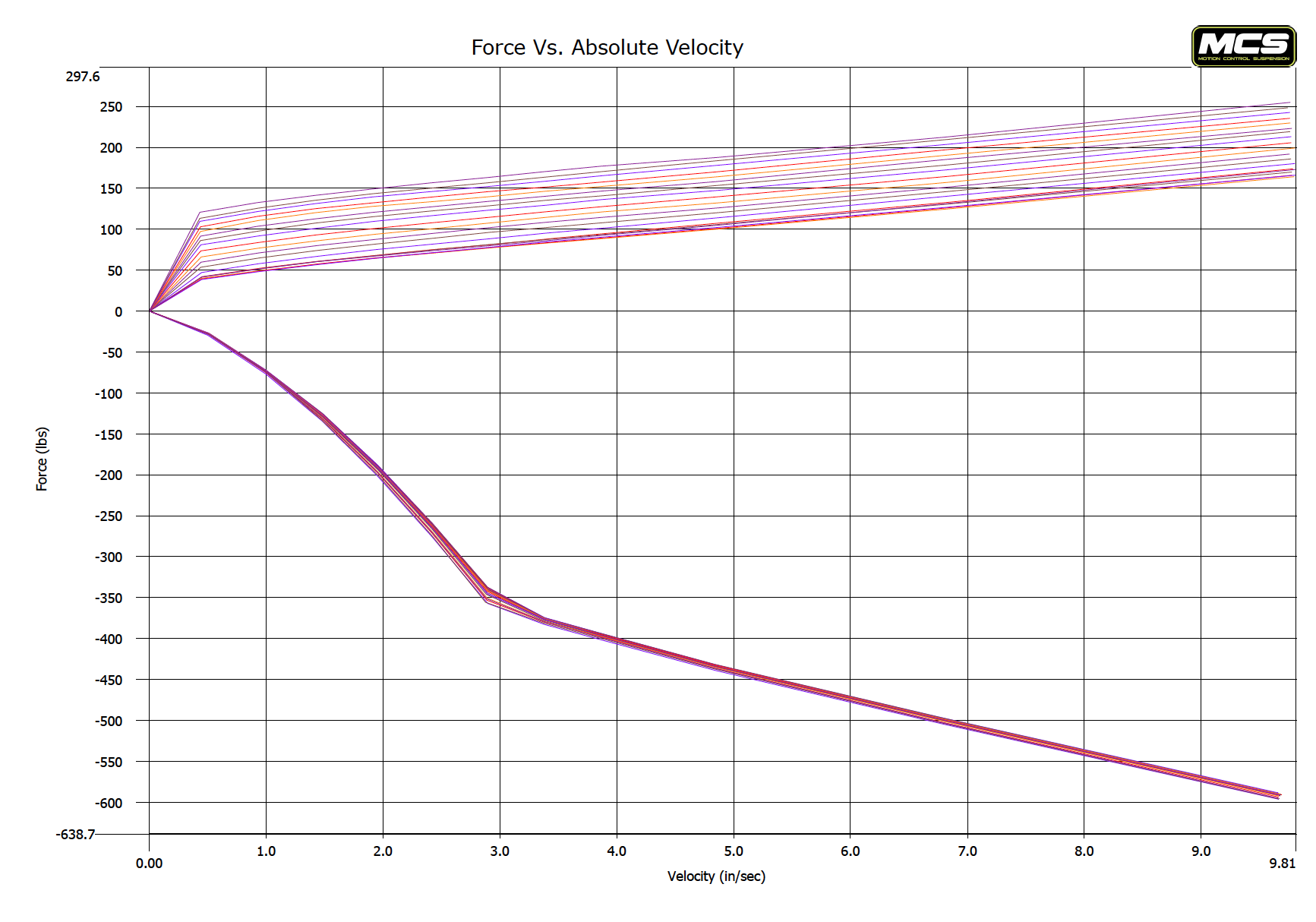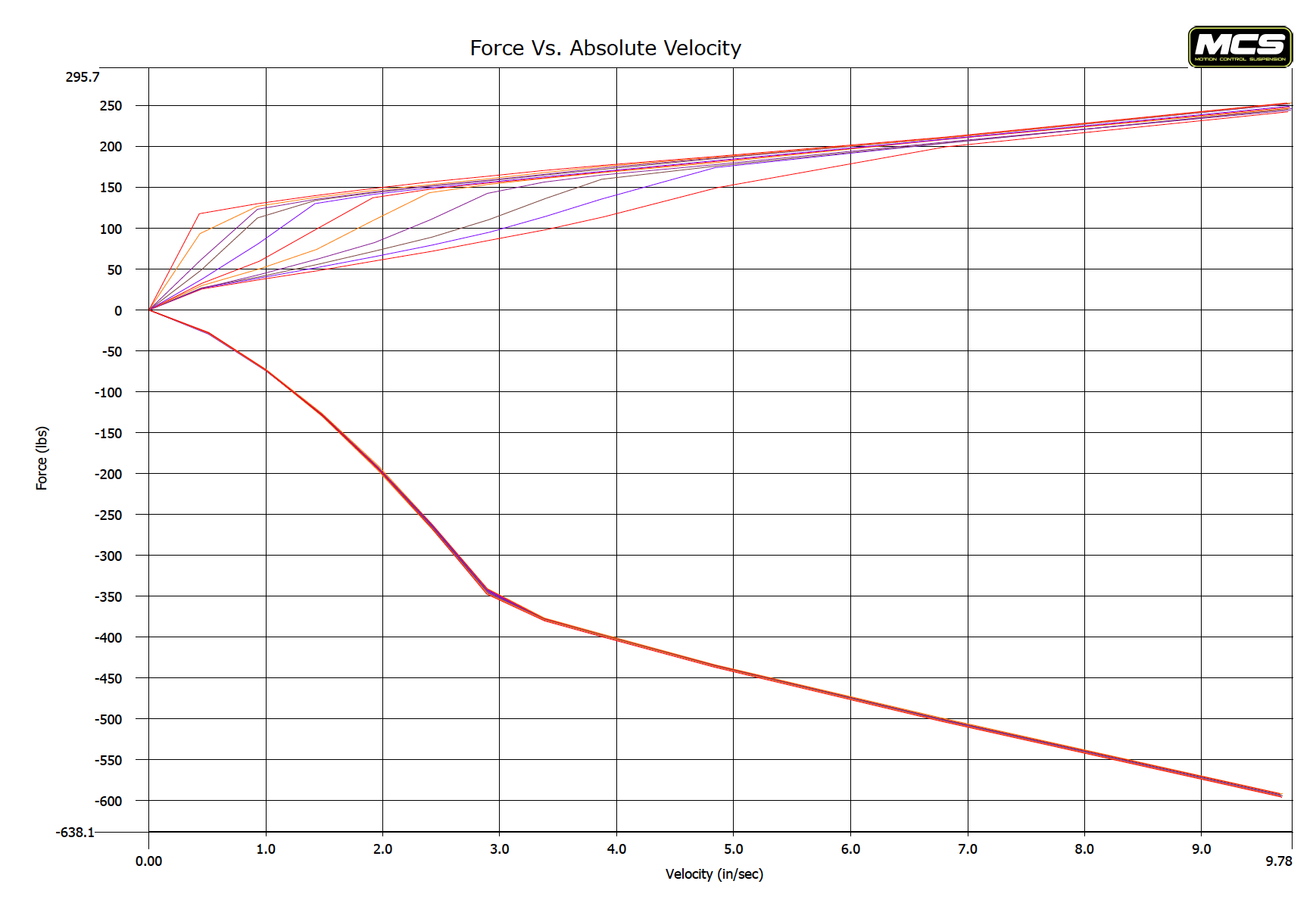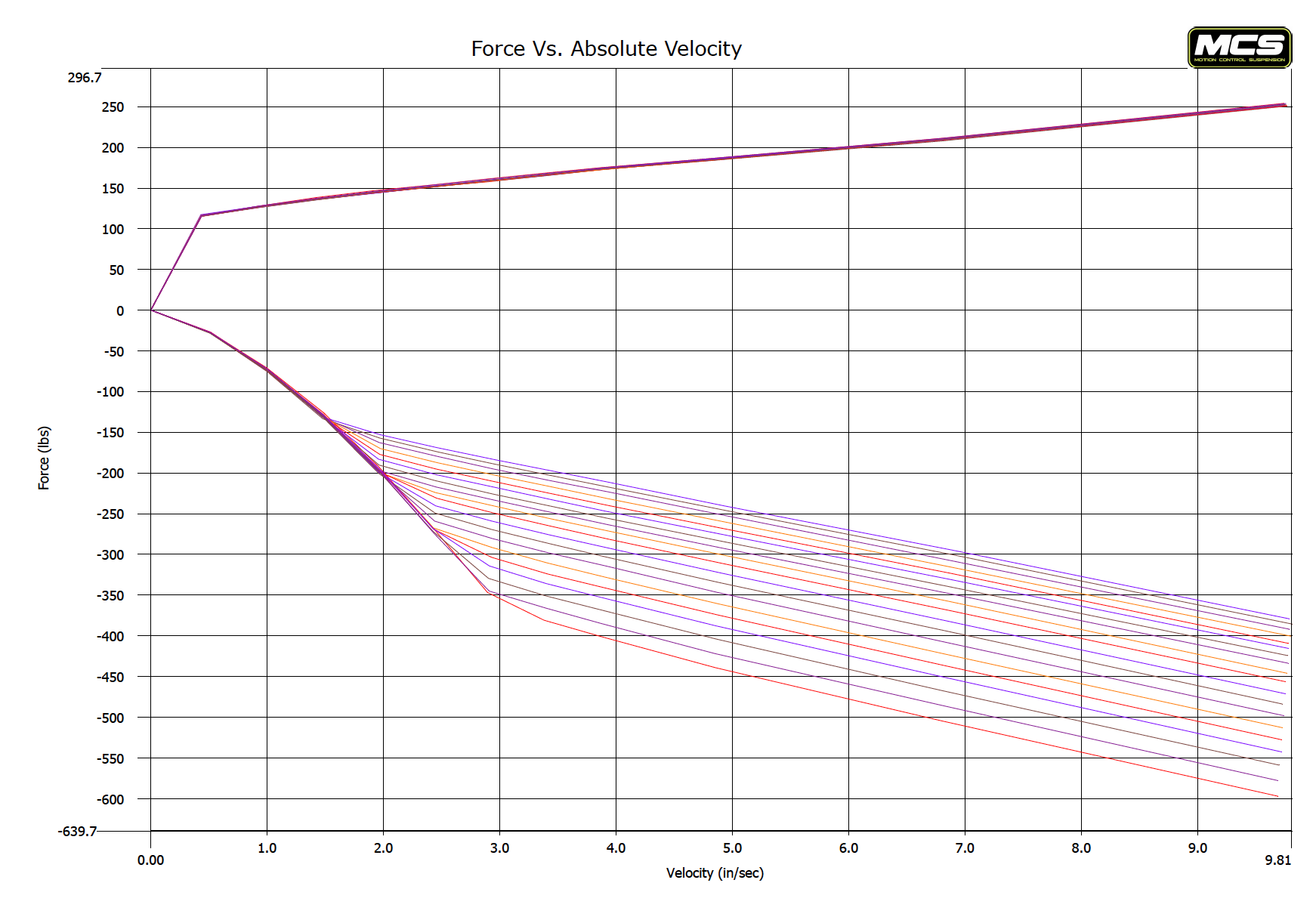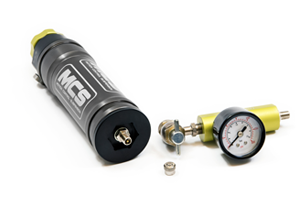MCS 4 Way
The MCS 4W is quadruple-adjustable damper with an external reservoir. High speed compression, low speed compression, high speed rebound, and low speed rebound damping forces are independently adjustable. Gas pressure is also adjustable. The high speed compression and low speed compression adjusters are located on the remote reservoir head. High speed rebound and low speed rebound damping forces are independently adjustable from one very clever knob. With the knob in the “down” position, high speed rebound forces are adjusted. With the knob in the “up” position, low speed rebound forces are adjusted.
High speed compression damping forces are precisely controlled by a large blow-off valve located directly within the piston assembly in the remote reservoir head. Low speed compression damping forces are controlled through orifices located directly within the piston assembly in the remote reservoir head and allow for precise hydraulic control of damper oil.
High speed rebound damping forces are precisely controlled by a blow-off valve located directly directly within the piston assembly inside the damper body. Low speed rebound damping forces are controlled through orifices located at the main piston assembly in the damper body and allow for precise hydraulic control of damper oil through the main piston assembly
Gas pressure can be adjusted through a schrader valve located at the end of the remote reservoir, allowing you to increase or decrease the overall support to the vehicle. Reservoir pressure can be adjusted between 100 – 275 PSI to help support the platform in fast cornering that generate large loads or allow more weight transfer to generate more traction in low grip scenarios.
These dampers are packed with technical features but with an elegantly clean execution. The monotube design is very stable with more oil capacity and better heat dissipation than twin tube dampers. Large shafts give extremely high, low-friction side-load support unmatched by shocks inverted and converted for strut applications. The large main piston gives quick, accurate damper response and the divider piston separates oil and gas, eliminating cavitation which often causes noise and sloppiness. Utilizing orifices introduces the ability to have a very defined operating range, consistency in the damping force adjustment per click, and virtually eliminates fatigue with usage. Blow-off valves effectively manage high speed forces to maintain maximum mechanical grip.
Adjustability
The MCS 4W damper is a quadruple-adjustable damper with an adjustment range of 18 clicks of high speed compression, 10 clicks of low speed compression, 18 clicks of high speed rebound, and 10 clicks of low speed rebound adjustment. User defined valving is specific to the preparation level of the car and data collected from the development of the car is implemented and carefully considered. The operating range of the MCS 4W damper is significantly more defined than our 2W and 3W remote systems, with less force change per click and more ability for the user to manipulate the shape of their damping curves at the turn of a knob.
- Low Speed Compression
- High Speed Compression
- Nitrogen Pressure Schrader Valve
- High Speed Rebound Adjuster
Knob in “down” position controls high speed rebound damping forces.
- Low Speed Rebound Adjuster
Knob in “up” position http://motioncontrolsuspension.com/wp-admin/post.php?post=2237&action=editcontrols low speed rebound damping forces.
18 Clicks of High Speed Compression Adjustment
High speed compression damping is easily adjusted on the MCS 4W damper. With 18 clicks of high speed compression control, the user can easily control the platform of the vehicle in high speed shaft movements (4 inches per second of velocity and beyond). This helps maintain the platform of the chassis through undulations and curb strikes on the compression stroke.
10 Clicks of Low Speed Compression Adjustment
Low speed compression damping is easily adjusted on the 4W damper. With 10 clicks of low speed compression control, the user can easily manipulate the pitch and roll of the vehicle in low speed shaft movements (0-4 inches per second in velocity). This helps to control how quickly a tire or axle loads.
18 Clicks of High Speed Rebound Adjustment
High speed rebound damping is easily adjusted on the 4W damper. The user can adjust high speed rebound forces to control stored spring energy in high speed rebound movements. This helps maintain the platform of the chassis through undulations and curb strikes on the rebound stroke.
10 Clicks of Low Speed Rebound Adjustment
Low speed rebound damping is easily adjusted on the 4W damper. The user can adjust low speed rebound control, the user can manipulate the pitch and roll of the vehicle on the rebound stroke in low speed shaft movements (0-4 inches per second in velocity). This helps to control how quickly a tire or axle unloads on the rebound stroke.
Gas Pressure Adjustment
Schrader valves are fitted on the ends of the reservoirs. This introduces a valuable tuning tool – the ability to increase or decrease the nitrogen pressure in your damper, allowing you to increase or decrease the overall support to the vehicle. Reservoir pressure can be adjusted between 100 – 275 PSI to help support the platform in fast cornering that generates large loads or to allow more weight transfer to generate more traction in low grip scenarios.
Technical Features

Low Speed Compression Adjuster Knob
Connected to the internal compression adjustment mechanism. Allows user to change low speed compression damping forces easily.
High Speed Compression Adjuster Knob
Connected to the internal compression adjustment mechanism. Allows user to change high speed compression damping forces easily.
Low Speed Compression Orifice
Contains proprietary internal adjustment mechanism for low speed compression damping forces.
Compression Main Piston Assembly
Contains proprietary internal adjustment mechanism for high speed compression damping forces.
Dividing Piston
Separates the gas cavity from the oil cavity.
Schrader Valve
Make gas pressure changes easily with a shock tool.
Rebound Main Piston Assembly
Generates overall valving range. Valving can be manipulated by changing the non-preloaded shim stack configuration on the compression and rebound sides of the piston.
Shaft Guide
Creates additional lateral support on shaft-end side of shaft assembly.
Shaft
Also known as piston rod. Responsible for displacing fluid in the damper body to be controlled by piston assembly and adjustment mechanism. We utilize 22mm diameter shafts for strut and shock applications for remote reservoir systems.
Low Speed Rebound Adjuster Knob
Connected to the internal rebound adjustment mechanism and allows user to change low speed rebound damping forces easily when in the "up" position.
High Speed Rebound Adjuster Knob
Connected to the internal rebound adjustment mechanism and allows user to change high speed rebound damping forces easily when in the "down" position.
MCS is our "go to" damper system for our race cars and has been for many years. I'll tell you a bit about the man who founded the company and who does all the design work as it is important to understand why you should consider buying MCS Suspension. MCS is headed by Jerome Van Gool, he is the "Brains" behind the designs and his resume speaks for itself. Jerome entered the suspension industry in 1990 and since then, Jerome has been building, designing, and servicing dampers for notable teams such as Alfa Corse, PTG, and GM in ALMS, Trans-Am, DTM, World GT Championship, as well as others.
He has been involved in over 100 European, Asian and US Championships and countless race wins, including 24 Hours of LeMans and the Nurburgring 24. Jerome’s work has also won FIA World GT, World Touring Car, World Sportscar, and a broad range of European and North American GT and Touring Car championships. So, it is needless to say that he designs one heck of a shock absorder system.
MCS offers some of the worlds best suspension available at any price for race and road going cars. The application list is extensive and if you do not see your application on the list, just give us a call because MCS can probably make what you need.
Monotube Construction
Monotube Construction is very stable with more oil capacity and better heat dissipation than twin tube dampers. The large main piston gives quick, accurate damper response and the divider piston separates oil and gas, eliminating cavitation which causes noise, sloppiness, and loss of traction. We use large diameter shafts better displace fluid inside the damper body and give extremely high, low-friction side-load support unmatched by shocks inverted and converted for strut applications.
Blow-Off Valves
Blow-off valves are extremely effective in managing high speed compression hits where shaft speed velocities can create significant increases in compression damping forces. Our proprietary blow off mechanisms are entirely unique to MCS and minimize a compression strike otherwise applied to a tire, resulting in a large loss of grip and in street applications, comfortable road manners.
Orifices
Orifices allow for precise hydraulic control of damper oil through the main piston. Utilizing orifices introduces the ability to have a wide operating range, avoiding pesky re-valves, consistency in damping adjustment per click, and virtually eliminates fatigue with usage.











